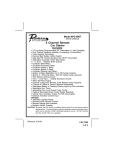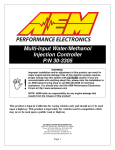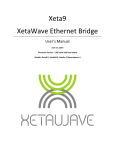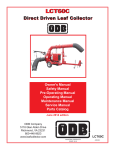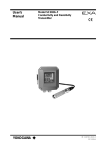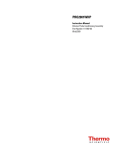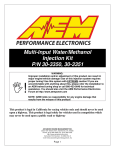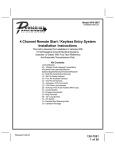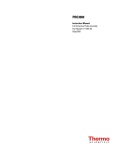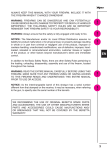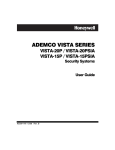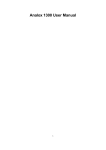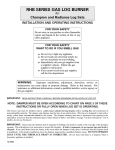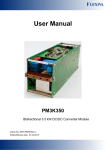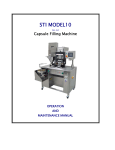Download Model PRO902C - User Manual
Transcript
PRO902C Instruction Manual Dilution Probe Conditioning Assembly & Remote Probe Controller Assembly Part Number 111981-00 16Aug2007 © 2011 Thermo Fisher Scientific Inc. All rights reserved. Specifications, terms and pricing are subject to change. Not all products are available in all countries. Please consult your local sales representative for details. Thermo Fisher Scientific Air Quality Instruments 27 Forge Parkway Franklin, MA 02038 1-508-520-0430 www.thermoscientific.com/aqi WEEE Compliance This product is required to comply with the European Union’s Waste Electrical & Electronic Equipment (WEEE) Directive 2002/96/EC. It is marked with the following symbol: Thermo Fisher Scientific has contracted with one or more recycling/disposal companies in each EU Member State, and this product should be disposed of or recycled through them. Further information on Thermo Fisher Scientific’s compliance with these Directives, the recyclers in your country, and information on Thermo Fisher Scientific products which may assist the detection of substances subject to the RoHS Directive are available at: www. thermoscientific.com/WEEERoHS. Thermo Fisher Scientific WEEE Compliance PRO902C MANUAL 1.0 2.0 3.0 PRODUCT DESCRIPTION 1.1 Introduction ..................................................................................................... 1-1 1.2 PRO902 description ........................................................................................ 1-1 1.3 Dilution probe conditioning assembly hardware ................................................ 1-2 1.3.1 Probe enclosure ................................................................................... 1-2 1.3.2 Enclosure heater .................................................................................. 1-2 1.3.3 Valve manifold and dilution air regulator............................................... 1-3 1.3.4 Heated filter, dilution eductor, and probe barrel assembly...................... 1-3 1.3.5 Heat exchanger and drain valve assembly ............................................. 1-4 1.3.6 TEI O2 analysis system ......................................................................... 1-4 1.3.6.1 O2 eductor .............................................................................. 1-5 1.3.7 Power, purge and temperature control .................................................. 1-5 1.3.7.1 Power distribution.................................................................. 1-5 1.3.7.2 Valve controller (watchdog) module ...................................... 1-5 1.3.7.3 Heated filter control module................................................... 1-5 1.3.7.4 Heat exchanger control module .............................................. 1-6 1.3.8 Absolute pressure transducer ................................................................ 1-6 1.4 Tubing and wiring umbilicals ........................................................................... 1-6 1.4.1 Tubing umbilical .................................................................................. 1-6 1.4.2 Wiring umbilical ................................................................................... 1-6 1.5 Remote probe controller assembly ................................................................... 1-6 1.5.1 Remote probe controller enclosure ....................................................... 1-7 1.5.2 Interface printed circuit assembly and O2 meter display ........................ 1-7 1.5.3 Temperature controllers........................................................................ 1-7 1.6 Specifications ................................................................................................... 1-8 THEORY OF OPERATION........................................................................................ 2-1 2.1 General ............................................................................................................ 2-1 2.2 Gas Flow functional description........................................................................ 2-1 2.2.1 Sampling mode..................................................................................... 2-2 2.2.2 Purge mode .......................................................................................... 2-3 2.2.3 Calibration mode................................................................................... 2-4 INSTALLATION AND OPERATION ........................................................................ 3-1 3.1 3.2 Rev 6.0 TFS Site location and preparation ............................................................................ 3-1 Limitations at the probe site.............................................................................. 3-2 August 16, 2007 ii PRO902C MANUAL TFS Claims for Damaged Shipments A. The PRO902C and remote probe controller assembly are shipped ready for operation. Immediate inspection of the PRO902C and remote probe controller assembly should follow upon receipt. Inventory of the container should be checked against the enclosed packing list. If there is a shortage of items, the operator should immediately contact TFS. If the contents are damaged, the carrier and the project manager at TFS should be notified immediately. B. The following documents are necessary to support claims: 1. Original freight bill and bill of lading. 2. Original invoice or photocopy of original invoice. 3. Copy of the packing list. 4. Photographs of damaged equipment and container. NOTICE Material contained in this manual is proprietary information of TFS. The TFS manual is to be used only for the installation, understanding, and servicing of this product. For further information or assistance contact: Thermo Fisher Scientific All rights reserved. No part of this publication may be reproduced or stored in a retrieval system or transmitted in any form or by any means, electronic, mechanical photocopying, recording, or otherwise, without the prior written permission of TFS. Revision No. 1.1 2.0 REVISION HISTORY Revision Made Pages Affected Revision Date Revise document to Word format/update Revised document All All 3.0 4.0 5.0 6 Changed Logo & TEI Changed O2 analyzer Changed List of Drawings Added Schematics All All 6-1 6-1, 6-9 June 25, 1999 October 13, 2000 April 12, 2001 Sept 28, 2006 Aug 16, 2007 Jan 4, 2008 Rev 6.0 August 16, 2007 i PRO902C MANUAL 1.0 2.0 3.0 PRODUCT DESCRIPTION 1.1 Introduction ..................................................................................................... 1-1 1.2 PRO902 description ........................................................................................ 1-1 1.3 Dilution probe conditioning assembly hardware ................................................ 1-2 1.3.1 Probe enclosure ................................................................................... 1-2 1.3.2 Enclosure heater .................................................................................. 1-2 1.3.3 Valve manifold and dilution air regulator............................................... 1-3 1.3.4 Heated filter, dilution eductor, and probe barrel assembly...................... 1-3 1.3.5 Heat exchanger and drain valve assembly ............................................. 1-4 1.3.6 O2 analysis system ......................................................................... 1-4 1.3.6.1 O2 eductor .............................................................................. 1-5 1.3.7 Power, purge and temperature control .................................................. 1-5 1.3.7.1 Power distribution.................................................................. 1-5 1.3.7.2 Valve controller (watchdog) module ...................................... 1-5 1.3.7.3 Heated filter control module................................................... 1-5 1.3.7.4 Heat exchanger control module .............................................. 1-6 1.3.8 Absolute pressure transducer ................................................................ 1-6 1.4 Tubing and wiring umbilicals ........................................................................... 1-6 1.4.1 Tubing umbilical .................................................................................. 1-6 1.4.2 Wiring umbilical ................................................................................... 1-6 1.5 Remote probe controller assembly ................................................................... 1-6 1.5.1 Remote probe controller enclosure ....................................................... 1-7 1.5.2 Interface printed circuit assembly and O2 meter display ........................ 1-7 1.5.3 Temperature controllers........................................................................ 1-7 1.6 Specifications ................................................................................................... 1-8 THEORY OF OPERATION........................................................................................ 2-1 2.1 General ............................................................................................................ 2-1 2.2 Gas Flow functional description........................................................................ 2-1 2.2.1 Sampling mode..................................................................................... 2-2 2.2.2 Purge mode .......................................................................................... 2-3 2.2.3 Calibration mode................................................................................... 2-4 INSTALLATION AND OPERATION ........................................................................ 3-1 3.1 3.2 Rev 6.0 TFS Site location and preparation ............................................................................ 3-1 Limitations at the probe site.............................................................................. 3-2 August 16, 2007 ii PRO902C MANUAL 3.3 4.0 Rev 6.0 TFS 3.2.1 Stack temperature extremes .................................................................. 3-2 3.2.2 Ambient temperature extremes.............................................................. 3-2 3.2.3 Process pressure ................................................................................... 3-2 General installation........................................................................................... 3-2 3.3.1 Dilution probe conditioning assembly.................................................... 3-2 3.3.2 Air supply............................................................................................. 3-5 3.3.3 Sample and calibration gas lines ............................................................ 3-5 3.3.4 Vent line ............................................................................................... 3-5 3.3.5 Power ................................................................................................... 3-5 3.3.6 Control and data lines ........................................................................... 3-6 3.4 Dilution probe conditioning assembly Start-up (City Technology O2) ....................................................................................... 3-6 3.5 4-20 mADC current output calculation............................................................. 3-9 3.6 City Technology O2 sensor alignment ..............................................................3-10 3.7 Absolute pressure transducer checkout procedure............................................3-11 3.8 Remote probe controller interface board setup procedure ................................3-11 MAINTENANCE........................................................................................................ 4-1 4.1 General ............................................................................................................ 4-1 4.2 Required maintenance equipment...................................................................... 4-1 4.3 Heated filter replacement .................................................................................. 4-1 4.4 Quartz orifice replacement................................................................................ 4-2 4.5 Probe head removal.......................................................................................... 4-2 4.6 Orifice holder assembly removal ....................................................................... 4-3 4.7 Eductor jet body removal ................................................................................. 4-3 4.8 Probe head leak Test ........................................................................................ 4-4 4.9 Probe Head Flow test ....................................................................................... 4-5 4.10 Eductor vacuum test......................................................................................... 4-5 August 16, 2007 iii PRO902C MANUAL 4.11 5.0 6.0 TFS Trouble Shooting ............................................................................................. 4-6 4.11.1 Zero drift – full system.......................................................................... 4-6 4.11.2 Span drift –full system........................................................................... 4-6 4.11.3 Low sample flow rate............................................................................ 4-6 4.11.4 High sample flow rate ........................................................................... 4-7 4.11.5 Low flow rate at the eductor exhaust .................................................... 4-7 4.11.6 High flow rate at the eductor exhaust .................................................... 4-8 4.11.7 Low eductor vacuum ............................................................................ 4-8 4.11.8 Low span reading.................................................................................. 4-8 4.11.9 High span reading ................................................................................. 4-9 ASSEMBLY REPAIR................................................................................................. 5-1 5.1 Obtaining replacement parts ............................................................................. 5-1 5.2 Spare parts list, CTL902C ................................................................................ 5-1 5.3 Spare parts list, PRO902C................................................................................ 5-2 5.4 Extended Parts List, PRO902C......................................................................... 5-3 5.5 Recommended tools ......................................................................................... 5-5 LIST OF DRAWINGS ................................................................................................ 6-1 LIST OF FIGURES 1.3 Dilution probe assembly ................................................................................... 1-4 2.2 Probe head flow diagram .................................................................................. 2-3 3.1 Enclosure mounting diagram ............................................................................ 3-1 3.3 Probe barrel assembly....................................................................................... 3-4 3.4 Probe controller front panel.............................................................................. 3-6 3.8-1 Remote probe controller interface board setup.................................................3-12 3.8-2 Remote probe controller assembly, top view....................................................3-12 3.8-3 Remote probe controller electronics ................................................................3-13 4.8 Rev 6.0 Probe head leak test configuration .................................................................... 4-4 August 16, 2007 iv PRO902C MANUAL 4.9 TFS Probe head flow test configuration.................................................................... 4-5 4.10 Eductor vacuum test configuration ................................................................... 4-6 LIST OF TABLES 1.4.2 Wiring umbilical table....................................................................................... 1-6 3.4.1 Setup menu parameters .................................................................................... 3-7 3.4.2 Operation setup menu....................................................................................... 3-8 Rev 6.0 August 16, 2007 v PRO902C MANUAL TFS 1.0 PRODUCT DESCRIPTION 1.1 Introduction The Installation and Operation manual provides instruction for basic installation, preventive maintenance, corrective maintenance, and trouble shooting procedures for the PRO902C dilution probe conditioning assembly and remote probe controller assembly. This manual contains four sections: Section 1 - Product description: Hardware description, instrument operating parameters, and physical characteristics. Section 2 - Theory of operation: Complete functional description. Section 3 - Installation and operation: Instructions for installation and operation of the dilution probe conditioning assembly. Section 4 - Maintenance: Routine inspection, troubleshooting, corrective procedures, and repair/replacement for major assemblies. 1.2 PRO902C description The PRO902C dilution probe conditioning assembly is a three-part package. Part one is the stack or duct mounted dilution probe conditioning assembly, part two is the wiring and tubing umbilicals, and Part three is the remote controller assembly. The dilution probe conditioning assembly draws, conditions, and dilutes the process emissions to be transported for analysis. The tubing and wiring umbilical connects the dilution probe conditioning assembly to the analyzers, calibration gas supply, purge instrument air supply, dilution air supply, and the remote probe controller assembly. Part three, the remote probe controller assembly, monitors and controls temperatures of subassemblies in the probe conditioning assembly, displays the City Technology O2 output, and connects the dilution probe’s alarm and control contact closures with the customer’s control system. PRO902C dilution probe conditioning assembly (please refer to the 7000 series probe box assembly drawings): 1. 2. 3. 4. 5. 6. Rev 6.0 24" x 24" x 9 3/4" NEMA 4X enclosure Enclosure heater Dilution air regulator Heated filter, dilution eductor, and probe barrel assembly Heat exchanger and drain valve assembly TEI O2 analysis system a. City Technology O2 cell (Citicel®) b. O2 pump (eductor) August 16, 2007 1-1 PRO902C MANUAL TFS 7. Heated filter control module 8. Valve control module (Watchdog) 9. Valve manifold Tubing and wiring umbilical (please refer to the 1200 series Umbilical Drawings): 1. Tubing umbilical 2. Wiring umbilicals - paired wiring umbilical, 12 shielded pairs, #20 AWG in PVC jacket. Remote probe controller assembly: please refer to the 7000 series probe controller drawings. 1.3 Dilution probe conditioning assembly hardware The PRO902C dilution probe conditioning assembly consists of eight subassemblies used to condition, analyze, and transport the sample: 1. Probe enclosure. 2. Enclosure heater. 3. Valve manifold and dilution air regulator. 4. Heated filter, dilution eductor, and probe barrel assembly. 5. Heat exchanger and drain valve assembly. 6. TEI O2 analysis system. 7. Probe power, purge and temperature control. 8. Absolute pressure transducer. 1.3.1 Probe enclosure The dilution probe and conditioning assembly is housed in a fiberglass enclosure that measures approximately 24 inches (H), by 24 inches (W), by 9.75 inches (D). The enclosure is designed to protect the instruments and electrical controls from highly corrosive atmospheres. 1.3.2 Enclosure heater The enclosure heater is located on the bottom, right-hand side of the enclosure (please refer to the 7000 series probe box assembly drawing, item 17). The assembly consists of one 400watt heat element, a 30 CFM fan, and an adjustable thermostat switch. The fan motor runs continuously when power is supplied to the probe conditioning enclosure heater. The heat element cycles on and off according to the temperature inside the enclosure. The temperature of the enclosure is maintained at 100°F by the adjustable thermostat. Rev 6.0 August 16, 2007 1-2 PRO902C MANUAL TFS 1.3.3 Valve manifold and dilution air regulator The air valve manifold provides distribution of the box purge and heated filter purge air, and a place to conveniently mount the four valves for the Probe conditioning assembly. The four valves include: SV-1, the calibration valve used to inject calibration gas in the heated filter chamber; SV-2, the 3-way purge valve; and SV-3 and SV-4, used to purge the heat exchanger. The dilution air regulator is located on the left side of the air valve manifold (please refer to the 7000 series probe box assembly drawings). The regulator is 0-60 PSI with a 0-60 PSI gauge. The set point is 30 PSI. 1.3.4 Heated filter, dilution eductor, and probe barrel assembly The dilution probe assembly consists of a hastelloy probe barrel and an eductor probe head as shown in Figure 1.3. An eductor assembly and a heated filter body make up the eductor probe head. A heated, high capacity, sub-micron filter is housed in a Teflon® filter body, located within the Probe Head, and can be easily replaced during preventive maintenance. The sampling probe barrel is typically a section of pipe with an outer diameter of 0.67 inches and an inner diameter of 0.50 inches. Probe barrel material is selected for compatibility with the process stream and is supplied in hastelloy C-276. The standard four (4) foot probe barrel has an approximate 5° bend to prevent excess water buildup within the probe barrel in saturated processes. EDUCTOR HOUSING ASSEMBLY DILUTION CHAMBER EDUCTOR JET SAMPLE CRITICAL ORIFICE EDUCTOR EXHAUST (DILUTED SAMPLE OUTLET) SURFACE MOUNT RTD EDUCTOR AIR DRIVE INLET SAMPLE CHAMBER EDUCTOR INLET (DRIED SAMPLE IN) PROBE BARREL MOUNTING FLANGE ORIFICE HOLDER PURGE/CAL GAS PORT PROBE BARREL FILTER CAP FILTER ELEMENT PROBE STOP FLANGE UNDILUTED SAMPLE GAS OUTLET Figure 1.3 Rev 6.0 Dilution Probe Assembly August 16, 2007 1-3 PRO902C MANUAL TFS 1.3.5 Heat exchanger and drain valve assembly The heat exchanger and drain valve are located on the left wall of the dilution probe Assembly. A thermoelectric cooled Teflon® block, a moisture collection reservoir, an ambient exposed aluminum heat sink, and purge valve comprise the heat exchanger system. The heat exchanger system removes moisture from the filtered sample immediately before dilution. The drain valve (SV-5) also allows the moisture trapped by the heat exchanger to dump during the purge mode. A thermoelectric (TE) cooler cools the heat exchanger block to its operational temperature of 45°F. The heat exchanger control module contains an AC to DC bridge rectifier circuit to provide the necessary DC power for driving the TE cooler. A shroud fan directs 100 CFM of air over a heat sink to dissipate the heat generated by the TE cooler. 1.3.6 O2 analysis system The oxygen analysis system includes a Citicel® O2 fuel cell. In the presence of 20.9 % O2 atmosphere, the Citicel® O2 sensor produces a 9-13 mVDC signal, and 0.00 mVDC when 0.00 % O2 is present. This signal is amplified to produce a 4-20 mADC signal from a looppowered transmitter located on the cell holder (the loop-power is powered by the 24V power supply located in the probe controller assembly). The signal travels down the wiring umbilical to the probe controller assembly and is input to the remote O2 zero/span printed circuit assembly. At the O2 zero/span printed circuit assembly, zero and span of the O2 4-20 mADC signal can be adjusted before the signal is sent to the DAHS or chart recorder and to the percent O2 panel meter. 1.3.6.1 O2 eductor The O2 eductor is the sample mover for the O2 analyzer and is located in the upper left-hand corner of the dilution probe conditioning assembly. The sample is drawn from the process stream through the O2 cell under a vacuum produced by regulated instrument air passing through the O2 eductor (the flow through the air jet stream creates the vacuum). 1.3.7 Probe power, purge and temperature control Probe power, purge and temperature control are maintained by three sections: a power distribution section, a valve controller (watchdog) module section, and a heated filter control module section. These three sections handle all power distribution and the digital interface from the probe controller assembly (please refer to the 7000 series probe assembly drawings). 1.3.7.1 Power Distribution Rev 6.0 August 16, 2007 1-4 PRO902C MANUAL TFS The power requirement is 120VAC, 800 watts, 60 Hz. AC hot is supplied to disconnect DC1. From DC1, AC hot is distributed to the valve controller watchdog module, the heat exchanger control module, the enclosure heater, and the enclosure utility light and outlet. TB2 supplies power and control for the heat exchanger temperature control. Please refer to the 7000 series drawings for the fuse schedule. 1.3.7.2 Valve controller (watchdog) module The valve controller (watchdog) module controls all valves and contains an internal timer for watchdog functions. Purge watchdog control is jumper-selectable for intervals of 8, 16, 32 or 64 minutes. The valve control module also houses the O2 zero and span request switches, which allow maintenance crews to apply O2 zero and O2 span gasses while working at the dilution probe assembly. 1.3.7.3 Heated filter control module The heated filter control module interfaces with the Watlow controller in the remote probe controller assembly to control the A/C heater for maintaining the factory set temperature of 285°F in the heated filter. 1.3.7.4 Heat exchanger control module The heat exchanger control module interfaces with the Watlow controller in the remote probe controller assembly to control a cartridge heater for cooling the heat exchanger block to a factory set temperature of 45°F. 1.3.8 Absolute pressure transducer The absolute pressure transducer is mounted on top of the purge valve (SV2) and produces a 4-20 mA signal, representing 0-15 psi absolute pressure. 1.4 Tubing and wiring umbilicals The tubing and wiring umbilicals are the main link between the dilution probe assembly and the analyzer rack. 1.4.1 Tubing umbilical The tubing umbilical supplies purge air, dilution air, calibration gas, and the sample return line for the analyzers in the analyzer rack. Purge air is supplied by the 1/2" black polyethylene tube at 60 PSI to the valve manifold. Dilution air is supplied by the 1/4" black polyethylene tube at 60 PSI to the dilution air regulator. Calibration gas is supplied by a 1/4" clear Teflon® tube at 30 psi (limited to 2500cc/minute by flow orifice) to the calibration gas inlet on the valve manifold. The sample outlet is connected to a 1/4" clear Teflon® tube, to supply the Rev 6.0 August 16, 2007 1-5 PRO902C MANUAL TFS analyzers in the analyzer rack with diluted sample. 1.4.2 Wiring Umbilical Table Pair Number 1.5 Function Signal 1 Heat exchanger RTD signal 4-20 milliamp 2 Heat exchanger control signal 3 Heated filter RTD signal 4 Heated filter control signal 5 Spare 6 Spare 7 Absolute pressure 8 Oxygen analyzer signal 9 O2 span request 0-24 VDC contact closure 10 O2 zero request 0-24 VDC contact closure 11 Calibration valve control 0-24 VDC contact closure 12 Purge control 0-24 VDC contact closure 0-24 VDC pulse modulation 4-20 milliamp 0-24 VDC pulse modulation 4-20 milliamp 4-20 milliamp (0-25%) Remote probe controller assembly The remote probe controller assembly monitors and controls temperatures of subassemblies in the dilution probe conditioning assembly. Subassemblies of the remote probe controller assembly include: 1. 2. 3. 4. 5. 3-1/2" X 15" X 17" rack mount enclosure with optional slides Interface printed circuit assembly O2 meter display Probe heated filter temperature controller Heat exchanger temperature controller 1.5.1 Remote probe controller enclosure The enclosure total length is 15 inches and the enclosure will mount in a standard 19-inch rack, excluding the additional space required on the back for connection of the two multiplepin plugs. Connection clearances require the rack to be at least 24 inches deep. Connector #1 and #2 are for connection to the dilution probe conditioning assembly, and connector #3 is for connection to the rack controller. A power entry module for a standard 115VAC cord connection is also on the back of the enclosure. 1.5.2 Interface printed circuit assembly and O2 meter display Rev 6.0 August 16, 2007 1-6 PRO902C MANUAL TFS The printed circuit assembly is manufactured by TFS and allows remote span and zero alignment of the 4-20 mADC signal generated by the O2 sensor. The card has one channel with an on-board power supply for the 4-20 mADC outputs and digital control signals. The meter outputs are 0-200 uADC, for meter display from 0-199.9. 1.5.3 Temperature controllers Two Watlow series 93 temperature controllers, located in the front of the CTL902C probe controller assembly, provide readouts in degrees Fahrenheit (°F) or degrees Celsius (°C), as selected in the controller setup menu. Each upper display is the actual temperature of the controlled device and each lower display is the temperature set point. On the face of each controller, located to the right of the temperature displays, are two LED’s, labeled “L1” and “L2.” L1 indicates that power is being applied to a heat element or to the TE cooler in the heat exchanger. L2 indicates that the temperature has strayed past the alarm set point and, if an alarm device is connected to the alarm output, an alarm will be sounding. The Watlow controllers monitor and control the probe heated filter temperature (275-285°F) and the heat exchanger temperature (35-45°F). Caution: The controllers are hooked to three-wire RTDs. The internal dip switch settings determine the type of temperature sensor used. For more information, please refer to the Watlow Series 93 User's Manual. 1.6 Specifications The PRO902C dilution probe conditioning assembly was designed to operate within the following specifications: Power requirements: Power connection: 115 VAC, 800 Watts CSA/UL Approved screw terminal. Terminal wire capacity up to 10 AWG. -20°C to 50°C (-4°F to 122°F) 600°C (1112°F) 2.0 L/minute minimum 2.5 L/minute maximum 37.7°C ± 3°C (100°F ± 5°F) 60 PSIG (400 kPa) minimum, 80 PSIG (550 kPa) maximum, via ½-inch tubing, 0.300 inch minimum I.D. Operating temperature range: Maximum process temperature: Calibration gas flow rate Enclosure temperature: Instrument air supply: Eductor flow rates: Heated eductor assembly: Rev 6.0 August 16, 2007 1-7 PRO902C MANUAL TFS Sample flow: Dilution flow: Eductor pump assembly: Sample flow: Dilution flow: Heat Exchanger: Cooler block temperature: Heated eductor/filter Body temperature: Materials of Construction: Enclosure: Sample orifice: Eductor jet: Eductor body: Orifice holder body Heated filter body: Probe barrel: Heat exchanger/cooling block: Connecting lines/sample lines: approx. 100-300 cc/minute approx. 5-10 L/minute approx. 100 cc/minute approx. 5 L/minute 7.2°C 5°C (45°F - 50°F) 140.5°C ± 5.5°C (285°F ± 10°F) Fiberglass Quartz Torlon® or suitable material Torlon® Torlon® or suitable material Stainless steel or suitable material Hastelloy - C276 Torlon® or suitable material Teflon® Weight: Dilution probe conditioning assembly: 82.5 lbs (37.4 kg) Oxygen sensor : Primary sensitivity Range Output signal Operating life in air at S.T.P. Preconditioning requirements Storage life in CTL container under clean dry conditions at 0-20°C off load Operating temperature range continuous Operating pressure range Operating relative humidity range Full scale output drift at S.T.P. continuous duty in air Output at 0.0% O2 Response time step changes, ambient air to N2, using a 47W load resistor Rev 6.0 August 16, 2007 Direct % O2 0-25% O2 .5mA ± 200µA @ 20.9%O2 100,000% hours minimum 1 hour on load 6 months -15°C to +40°C Ambient ± 10% 0-99% RH non-condensing < 2% full-scale/month <200ppm O2 equivalent >95% in 20 seconds 1-8 PRO902C MANUAL 2.0 THEORY OF OPERATION 2.1 General TFS The PRO902C dilution probe conditioning assembly extracts a continuous sample from a stack or duct, removes entrained liquids and water vapor, measures oxygen content of the sample gas, and delivers a clean dry sample for transport to a gas analysis system. The PRO902C delivers a 4-20 mADC oxygen output signal for data retrieval and produces a closure (alarm) for low system air pressure. 2.2 Gas flow functional description A regulated source of instrument air is connected to the dilution eductor jet through the pressure regulator (PR-1) and pressure gauge (PI-1). The pressure regulator precisely regulates the air pressure to within 0.04 PSI (.3kPa) for a 10 PSIG (70kPa) change in input pressure. The flow through the air jet creates a vacuum that pulls the sample gas through the dilution probe conditioning system and is also used to dilute the sample gas to lower concentrations: therefore, the air supply quality and pressure are vital for proper probe operation. The dilution eductor air flow rate is set and controlled by a dilution critical orifice in the air jet, operated at 30 PSIG (200kPa) to provide the sample gas critical orifice pressure drop of 15 inches Hg (50kPa), or greater. The dilution air and sample gas flow rate may be set by selecting different orifice combinations. Dilution flow rates (between 5 and 10 liters/minute) may be chosen in combination with different process sample gas flow rates (between 50 and 300 cc/minute) to yield dilution ratios between 16:1 and 100:1. The process sample gas and dilution air are combined within the eductor, and the diluted sample gas exits the dilution eductor assembly through the eductor exhaust port. In the primary sample path (the dilution path), the heated eductor assembly pulls a portion of the dry, undiluted sample gas from the heat exchanger into the heated eductor sample inlet. Please see Figure 2.2, probe head flow diagram. It is then carried through a protection filter and sample critical orifice into the dilution chamber for dilution. The protection filter protects against particulate matter that may be dislodged during the heated filter replacement. Installed immediately downstream of the heat exchanger, this one-micron filter protects both the O2 eductor pump and the heated eductor assembly. The filter does not normally require maintenance, but visibly indicates when contamination may be present. The eductor sample critical orifice, contained within the filter/jet cartridge, is fabricated from quartz. The orifice temperature is maintained at 140.5°C ± 5.5°C (285°F ± 10°F). From the orifice, the process gas passes to the vacuum cavity of the dilution eductor. The dilution eductor assembly is heated by an extension of the heated aluminum housing. From the eductor exhaust port, the diluted process gas passes to a vent bulkhead on the conditioning assembly enclosure. A portion of the diluted sample is pulled through a sample Rev 6.0 August 16, 2007 2-1 PRO902C MANUAL TFS bulkhead and the unheated Teflon® sample line by a sample transport pump to the remote analysis system. In some cases, the sample transport assembly may be eliminated if the distance between the probe assembly and the remote analyzer is 50 feet or less. Typical transport flow rates from the conditioning assembly to an external analysis system range from 1.5 to 3.0 liters per minute. This gives the analytical instruments a response time of 2 to 5 minutes, depending upon application, which is adequate for most process control and environmental monitoring requirements. System response time requirements have been met with the PRO902C dilution probe conditioning assembly by a three-step process. Upon extraction from the stack, the process sample gas is filtered, dried via the heat exchanger, and diluted. In the secondary sample path (the oxygen path), the Eductor Pump Assembly pulls the dry, undiluted sample gas from the heat exchanger through an in-line filter (F2) into the oxygen analyzer sample inlet. The sample gas passes through the oxygen analyzer into the eductor pump inlet and is then transported to vent. To further simplify the gas conditioning system, the process stream is immediately diluted at the sample source using dry air with dew points in the range of -40.0°C to -73°C (-40°F to 100°F). The dew point of the gas stream leaving the PRO902 probe is primarily a function of the dilution air dew point. Dilution ratios of 16:1 to 100:1 are easily achieved. The exit sample dew point of -7.8°C to -37.2°C (0°F to -35°F) allows use of unheated sample lines in all but the most extreme environments. Operation of the dilution probe conditioning assembly consists of three modes: Sampling, Purge, and Calibration. 2.2.1 Sampling mode Process gas enters the sampling system at the probe tip and flows down the probe at a low flow rate of 50-300 cc/min. Particles larger than 5 microns settle out on the probe walls due to the low sample velocity. From the sampling probe, the gas enters the heated filter chamber shown in the cross section in Figure 2.2, below. The filter body is heated and controlled by an external temperature controller and cartridge heating element between 135°C - 146.1°C (275°F - 295°F). The sample gas then flows from the heated filter chamber through the heated filter and exits from the heated filter body through the filter chamber outlet. The glass fiber filter element, with a Teflon® binder having a 0.1-micron efficiency rating, is selected for its inertness to the process gas. The filter element may be replaced by removing the filter cap and 0-Ring. The filtered sample gas is then conditioned by the heat exchanger. The sample gas is extracted using two precision, low flow Eductor Assemblies that are driven by instrument quality air. The heated eductor assembly and the eductor ump assembly pull a portion of the total sample flow through the heated filter and the heat exchanger. Rev 6.0 August 16, 2007 2-2 PRO902C MANUAL TFS Once the filtered sample gas enters the Teflon® heat exchanger cooling block, any condensable or entrained liquids are condensed and collected in the liquid reservoir at the lower extreme of the cooling block. The heat from the cooling block is removed using a thermoelectric cooler and then transferred to the externally mounted aluminum heat sink. The temperature of the block is maintained by the heat exchanger controlling the electronics. EDUCTOR EXHAUST (DILUTED SAMPLE OUT) EDUCTOR AIR DRIVE INLET EDUCTOR INLET (DRIED SAMPLE IN) SAMPLE GAS PARTICLES 5 MICRON AND LARGER FILTER ELEMENT UNDILUTED SAMPLE GAS OUTLET TO HEAT EXCHANGER Figure 2.2 Probe Head Flow Diagram At the outlet of the heat exchanger, the dry sample gas is separated into two sample lines. One sample path is for dilution and transportation to a remote or local analysis system and the other sample path is for oxygen analysis. 2.2.2 Purge mode A purge cycle occurs periodically to clear various sections of the dilution probe Assembly and heat exchanger from moisture and particulate matter. The purge solenoid valves are operated automatically through a controller in the remote or local analysis system. The filter body and probe barrel are purged in a simultaneous two part process while the moisture collection reservoir is dumped to clear the heat exchanger. Purge frequencies may vary from every 15 minutes, for applications with extremely heavy particulate concentrations, to several hours for cleaner applications. The pulse lasts approximately 10 seconds. Longer purge times could result in dilution probe cooling. Particulate matter is removed from the probe barrel and the heated filter by the periodic introduction of high pressure air from the purge solenoid valve (V-2), and the heated filter/exchanger purge solenoid valve (V-4), into the filter body and exiting into the Rev 6.0 August 16, 2007 2-3 PRO902C MANUAL TFS process through the probe barrel. The heated filter/exchanger purge is used to remove particulate buildup from the inside surface of the heated filter. When the particulate is dislodged, it is carried out of the filter chamber and through the probe barrel with purge air. The heated filter/exchanger purge air enters the heated filter body through the sample gas outlet and simultaneously enters the heat exchanger cooling block inlet. The purge air is introduced through the filter cap that houses the purge/calibration gas inlet. Moisture is removed from the heat exchanger sample inlet line and the moisture collection reservoir during the purge cycle. The moisture reservoir drain valve (V-3) opens to drain collected moisture from the conditioning assembly. The high-pressure purge air from the heated filter/exchanger purge solenoid valve (V-4) enters the cooling block inlet to force out the moisture from the block through the drain opening (V-3). 2.2.3 Calibration mode The PRO902C dilution probe conditioning assembly is calibrated by passing a gas of known concentration through all the components in the sample analysis system and adjusting the response of the gas analysis system to reflect the known value of the calibration gas. Calibrating in this manner compensates for total system losses in filter elements or other pneumatic components, changes in dilution air flow rates and changes in process gas flow rates. A typical calibration gas flow path is as follows: from the calibration gas cylinder, the gas flows through a flow controlling device and calibration gas valve, located in a remote or local gas analysis system, through the calibration gas line to the PRO902C dilution probe conditioning assembly calibration gas inlet. The gas enters the dilution probe through the calibration gas solenoid valve (V-1) and then into the filter body through the purge/calibration gas inlet. The calibration gas solenoid valve allows the flow of calibration gas to be initiated remotely through a controller in the remote or local analysis system. The calibration gas valve is located as close as possible to the purge/calibration gas inlet to prevent process condensation from forming in the calibration line between calibrations. From the heated filter body, the calibration gas passes through all system components at the same flow rates and conditions as the process sample gas. Rev 6.0 August 16, 2007 2-4 PRO902C MANUAL TFS 3.0 INSTALLATION AND OPERATION 3.1 Site location and preparation 40 CFR Performance Specification Two (2) provides a guide to proper site selection, and lists several points that should be considered for most applications. The most accurate readings will usually be obtained when Performance Specification Two (2) is followed. The PRO902C dilution probe conditioning assembly is installed on a four (4) inch pipe flange. The pipe flange must be installed on a pipe nipple extending six (6) inches from the outer wall of the stack. The nipple is used to allow clearance behind the conditioning assembly for installation of the four (4) 1/2-inch X 1-3/4 inch stainless steel mounting bolts. Also allow a clear space, at least the width of the probe enclosure, in front of the enclosure door to allow the door to be opened. The four (4) inch pipe flange must be aligned as shown in Figure 3.11. A slip-type pipe flange is recommended to insure that the conditioning assembly can be leveled. (SEE NOTE-4) (SEE NOTE-5) MAIN POWER DISCONNECT (SEE NOTE-2) (SEE NOTE-1) TEFLON LINED PROBE EXTENDING INTO STACK 3/8" PIPE HASTELLOY C-276 (SEE NOTE-4) (SEE NOTE-3) STACK WALL 48" (MINIMUM) (SEE DETAIL-A) 72" (MAXIMUM) MAINTENANCE CLEARANCE (SEE NOTE-9) VIEW 'A'-'A' FLANGE WELDED TO PIPE SPOOL IN THIS CONFIGURATION CATWALK OR FLOOR (RECOMMENDED MINIMUM) NOTES: 1. DO NOT ALLOW BURRS ON INSIDE DIAMETER OF 4" SCHEDULE 40 PIPE (SUPPLIED BY CUSTOMER) 2. WELD PIPE TO STACK USING 1/4" FILLET WELD 3. (A) - USE THESE FOUR HOLES FOR PROBE INSTALLATION BOX FOR ACCESS 6. CUSTOMER SUPPLIED AND INSTALLED 7. CUSTOMER IS TO ENSURE THE STRUCTURAL INTEGRITY 8. ALLOW 24" CLEARANCE FOR DOOR OPENING 9. ALLOW 30" CLEARANCE IN FRONT OF PROBE OF THE STACK OR DUCT AT ALL PENETRATIONS 10. CLEARANCE FOR MAINTENANCE 4. PROBE LENGTH WILL MEET US EPA 1 METER PENETRATION REQUIREMENT; MAY BE SHORTENED, IF NECESSARY, TO PLACE PROBE TIP AT CENTER OF GAS STREAM 5. ALLOW 6" CLEARANCE BETWEEN FLANGE AND WALL OR FLANGE AND INSULATION Figure 3.1 Rev 6.0 Enclosure Mounting Diagram August 16, 2007 3-1 PRO902C MANUAL TFS The dilution probe conditioning assembly should be installed in a location that will allow maintenance personnel access to the front of the enclosure. All maintenance can be performed from the front of the unit. 3.2 Limitations at the probe site The placement of the PRO902C dilution probe conditioning assembly is important to achieve its maximum reliability. 3.2.1 Stack temperature extremes The PRO902C probe barrel was supplied using hastelloy C-276, Teflon® lined hastelloy C276, or other suitable material specific to the application. The Teflon® lined hastelloy probe barrel may be used at temperatures up to 190.5C (375F) and lengths up to six (6) feet long. Use the shortest possible probe barrel length (less than six feet) for proper response times and consistent sampling practice. 3.2.2 Ambient temperature extremes The PRO902C dilution probe conditioning assembly may be operated at a maximum ambient temperature of -20C to 50C (-4F to 122F). This upper temperature is selected to assure proper operation of the electronic circuitry and solenoid valves contained in the enclosure. Optimum operation of the sampling system will always be achieved if a sampling location is selected with moderate temperatures. 3.2.3 Process pressure The sampling system should not be installed in sampling locations that have pressures that exceed +5 inches H2O (1.2kPa) or -10 inches H2O (-2.5kPa). Positive pressure ducts are a special problem because process gases may escape into the area of maintenance personnel when the filter body is opened for maintenance. Positive pressure stacks or ducts may be easily sampled if a small portion of the stream is vented to atmosphere and the probe installed to sample this atmospheric vent. The probe typically pulls between 50 and 300 cc/minute, requiring only a small bypass flow. 3.3 General Installation 3.3.1 Dilution probe conditioning assembly The dilution probe conditioning assembly is shipped in two separate containers. The conditioning assembly is installed first and then the probe barrel is installed through the back of the conditioning assembly into the stack. To install the dilution probe conditioning assembly, perform the steps outlined in the following three sections. Rev 6.0 August 16, 2007 3-2 PRO902C MANUAL TFS Conditioning assembly installation Install the conditioning assembly on the four (4) inch flange using a proper flange gasket and four 1/2 inch X 1-3/4 inch stainless steel bolts: please see Figure 3.1. Probe head removal A) Open the conditioning assembly door and locate the dilution probe head. Carefully cut and remove the shipping tie wrap from the probe head and support bracket. B) Note the placement of all five (5) Teflon® tubes connected to the probe head. Loosen each of the Teflon® tube connection fittings and remove the tubes. C) Disconnect the cartridge heater and the RTD from the probe box wiring. D) Loosen the probe head securing wing nut, located underneath the support bracket. E) Remove the probe head from the bracket and place in a safe, clean area during probe barrel installation. Probe barrel installation A) Inspect the probe barrel assembly for proper flange spacing and orientation (factory set): please see Figure 3.3 on the following page. B) Install the probe flange gasket (factory supplied) over the process end of the probe barrel, for sealing process gases from the conditioning assembly enclosure. C) Insert the probe barrel assembly through the flange porthole, in the back of the conditioning assembly, with the bend downward. Align the three-hole probe mounting flange and flange gasket to the three-hole pattern of the conditioning assembly flange porthole. D) Insert the three (3) supplied 1/4-20 X 1-3/4 inch bolts through the probe mounting flange into the threaded holes, and tighten. E) Coat the polished probe tip surface with a liberal amount of silicone-based high vacuum grease. This allows a proper o-ring seal of the probe head. Rev 6.0 August 16, 2007 3-3 PRO902C MANUAL TFS TOP CENTER .5 In 1.0 In Figure 3.3 MOUNTING GASKET Probe Barrel Assembly Probe head installation NOTE: Before initial installation of the dilution probe assembly, and after any probe head maintenance, the tests described in Sections 4.9 and 4.10 of this manual should be performed. The probe pre-test verifies that the probe assembly is leak free and has the proper flow rates. A) Reinstall the probe head by sliding the probe head over the polished probe tip. The rear of the probe head is usually tilted upward during installation to allow clearance for the sample outlet fitting. B) Reinstall all items removed during steps B and C of the probe head removal section: Rev 6.0 1) Connect the eductor dilution air. 2) Connect the eductor exhaust tube. August 16, 2007 3-4 PRO902C MANUAL TFS 3) Connect the eductor inlet tube. 4) Connect the calibration/purge tube. 5) Connect the sample outlet tube. 6) Connect the probe filter heater cartridge. 7) Connect the RTD on top of the heated filter, next to the eductor assembly. 8) Check all connections and confirm that the cartridge heater and thermistor are installed to maximum depth. 3.3.2 Air supply NOTE: Do NOT apply pressure to the conditioning assembly until start-up, Section 3.4. This section is for an air line connection, only. The air supply must have a dew point of at least -40C (-40F). A low dew point will prevent condensation in the unheated sample line and reduce sample loss. The air supply should have a minimum pressure of 60 PSIG (400kPa) to ensure an adequate purge. The typical TFS air clean-up assembly meets these requirements. Connect a 1/2-inch O.D. minimum air supply line to the instrument air inlet of the conditioning assembly. The instrument air supply inlet is accessed through a 1/2-inch stainless steel compression tube fitting located at the bottom of the conditioning assembly. 3.3.3 Sample and calibration gas lines Connect the Teflon® sample and calibration gas lines to the appropriate 1/4-inch compression type tube fittings located at the bottom of the conditioning assembly. The maximum length for the sample and calibration lines varies with individual applications. Please refer to the specific installation drawings for each application. 3.3.4 Vent line A ¼ inch rubber grommet and Teflon® tube are supplied for the vent. NOTE: The sample vent/eductor exhaust should never be restricted or pressurized. 3.3.5 Power A standard 115VAC, 15A service is required to operate the PRO902C dilution probe conditioning assembly. Service must be supplied using 12 AWG minimum. For long runs Rev 6.0 August 16, 2007 3-5 PRO902C MANUAL TFS where voltage drops may occur, 10 AWG may be used. Connect the power to disconnect switch DC1, TB-1 and the grounding screws (please refer to the site-specific wiring drawings). DC1 is a UL and CSA approved disconnect switch rated for 10 AWG wire, 20 Amps AC. A power cable entry to the conditioning assembly is supplied through a ¾ inch conduit hub. 3.3.6 Control and data lines Connect signal lines using specified shielded cable for oxygen data acquisition, and control lines for calibration, and purge valves. A cable entry to the conditioning assembly is supplied through a ½-inch CGB. (Please refer to specific installation drawings for each application site.) 3.4 Dilution probe conditioning assembly start-up/City Technology O2 A) The dilution probe conditioning assembly start-up procedure may be performed only after the installation procedure outlined, above, has been completed and all wiring and tubing connections have been rechecked for accurate hook-ups. Figure 3.4 B) Rev 6.0 Probe Controller Front Panel Heated filter and heat exchanger temperature controller setup procedure. August 16, 2007 3-6 PRO902C MANUAL TFS 1. Remove the Watlow controllers from the front panel and check the dip switches on the backs of the controllers: both switches should be in the “on” position. 2. Reinstall the temperature controllers and apply power to the remote probe controller assembly via the power switch located at the rear of the chassis. 3. Please refer to Table 3.4-1, below, for parameter set points for each controller. Enter the setup menu by pressing and holding the up and down arrows on the controller for three seconds. The controller will enter the setup menu when “LOC” is displayed on the lower window. 4. To proceed to the next parameter press the (Advance) key. NOTE: all outputs will be switched off while in the setup menu. Parameter LOC In dEC rL rH Ot1 HSC Ot2 HSA LAt SiL rP PL dSP Function Lockout security level Input type Decimal point placement Low temperature range High temperature range Output type #1 Hysterisis control Output type #2 Alarm hysterisis (dead band) Alarm latching Alarm silencing Ramping (not used) Power limiting Display windows Table 3.4-1 Rev 6.0 Heated Filter Settings 0 420 0 32 626 Ht 3.0 dEA 2 NLA OFF OFF 100 NOr Heat Exchanger Settings 0 420 0.0 0 176 Cl 0.3 dEA .2 NLA OFF OFF not used NOr Setup Menu Parameters August 16, 2007 3-7 PRO902C MANUAL TFS 5. Please refer to Table 3.4-2, below, for parameter set points for each controller. Enter the operation menu by pressing the (Advance) key. The controller is in the operation menu when “Pb1” is displayed on the lower window. To proceed to the next parameter, press the (Advance) key. These parameters will be automatically entered after the Auto-tune is complete. Parameter Pb1 rE1/dE1 Ra1/dE1 Ct1 ALO AHI CAL Aut Function Heated Filter Settings 6 .17 .29 1.0 -10.0 +10.0 0.0 Do Not Autotune Power band #1 Reset #1 Rate #1 Cycle Time #1 Low alarm set point High alarm set point Calibration offset Autotune function* Table 3.4-2 Heat Exchanger Settings 15 0.15 0.1 1.0 -5.0 +5.0 0.0 Do Not Autotune Operation Setup Menu * Autotune will be engaged when a value other than 0 is entered into the Aut Parameter. When the Autotune is complete, the value will automatically revert back to 0. Rev 6.0 C) Go to the dilution probe assembly and verify that the dilution air regulator has been turned off. This will keep moisture from contaminating the system until temperature set points are reached. D) Apply power to the dilution probe assembly by turning on the rotary power switch. Using a digital thermometer, check the temperature of the heated filter assembly and the heat exchanger assembly, via the thermocouple port drilled into each assembly. Make sure that both temperatures are approaching their set points. When both temperatures have stabilized, return to the probe controller assembly for the next step. E) At the controller, check that both temperature controllers show a temperature within 10°F of the set point. On the heated filter temperature controller, push the (Advance) key until “Aut” is on the display and use the “up” key to enter a “2.” The controller will begin an autotune and the Heated Filter temperature will cycle up and down until the controller has set autotune parameters. Do not perform the autotune on the heat exchanger temperature controller. F) Using a digital thermometer, verify the heat exchanger temperature is 45° ± 5° F. G) Using a digital thermometer, verify the heated filter temperature is 285° ± 10° F. H) Verify that the probe enclosure temperature is 100°F. August 16, 2007 3-8 PRO902C MANUAL 3.5 TFS I) Turn on the main air supply from the air clean-up assembly and adjust the dilution air supply regulator (PR1) to 30 PSI (200kPa). J) Complete the leak, flow and vacuum tests outlined in sections 4.8, 4.9 and 4.10. K) Complete a purge cycle on the dilution probe conditioning assembly. L) The dilution probe is now ready to be calibrated with the complete CEM system. 4-20 mADC current output calculation The first step in calculating the current output for a given gas concentration is to specify the full-scale value of oxygen. The most widely used full-scale value is 25%. This value allows approximately 4% oxygen headroom when monitoring atmospheric oxygen levels. The 25% full-scale value prevents input circuit saturation when atmospheric levels are pulled into the PRO902C dilution probe conditioning assembly during periodic maintenance. A full-scale value of 10% oxygen is used when lower levels of oxygen are typically present in the process. The second step requires finding the calibration gas percentage of full scale. For example, if a full-scale value of 25% oxygen is selected, and there is a calibration span gas of 20.9% oxygen, then 20.9 divided by 25 equals 0.836. This shows that 20.9% oxygen is 83.6% of the full scale 25% oxygen: span gas concentration ------------------------------ = % of full-scale full-scale concentration 20.9 % O2 ------------- = 83.6% or 0.836 of full-scale 25 % O2 Now that the gas concentration's percentage of full-scale is determined, calculate the current output by taking the percentage of full-scale value, in this example 83.6% (or 0.836), and multiplying it by sixteen (16), then adding four (4). The total current change is 16 mA from zero percent oxygen to the full scale value, with four (4) added to give a baseline or reference in milliamps to equal 0% oxygen: ( % of Full Scale * 16) + 4 = mADC output Rev 6.0 August 16, 2007 3-9 PRO902C MANUAL TFS In this example, 17.376 mA equals 20.9% oxygen: ( 0.836 * 16) + 4 = 17.376 mADC output Four (4) mA has been set to equal 0% oxygen and 20 mA has been set to equal 25% oxygen (full-scale). Therefore, 12 mA is the midpoint between 4 and 20 mA and equals 12.5% oxygen, which is half the full-scale value (25%) in our example. 3.6 City Technology O2 sensor alignment NOTE: ALLOW ONE (1) HOUR MINIMUM INITIAL RUN TIME ON CELL BEFORE PROCEEDING. A) At the dilution probe conditioning assembly, locate the O2 cell holder and remove the two wire jack attached to the red and black leads. Attach a DC volt meter to the leads. B) Locate the two switches on the right-hand side wall of the enclosure. Select the O2 zero request position. In this position, the cell output will drop to 0.0 mV DC (only if there are no leaks in the system). Let the system run on O2 zero gas for approximately 5 minutes or until the cell output stabilizes. C) Verify that the cell's output is acceptable (0.0 mV DC), then disconnect the DC volt meter and plug the jack back into its socket. Attach a DC ammeter in series with terminal (22) of the valve controller watchdog module, VCM1. D) Verify that the O2 zero switch is in the “ON” position and that the cell’s output has stabilized. Adjust the output, if required, to 4 mADC using the zero potentiometer. E) Turn the O2 zero request switch back to the "Auto" position and place the O2 span request switch to the "On" position. The span value of the 4-20 mADC output is calculated using the following formula: span gas concentration ------------------------------ = % of full scale full scale concentration ( % of Full Scale * 16) + 4 = mADC output Example: Rev 6.0 August 16, 2007 3-10 PRO902C MANUAL TFS 25 % O2 full-scale 20.9 % O2 span gas concentration 20.9 % O2 ------------- = 0.836 or 83.6% of full-scale 25 % O2 ( 0.836 * 16) + 4 = 17.376 mADC output F) After the cell has stabilized, adjust the span potentiometer (R18 on the remote O2 PCA) to the calculated mADC output (please refer to figure 3.7-1 for span potentiometer location). G) Now place the O2 span request switch back to the "Auto" position. Note: Steps "D" through "G" need to be accomplished at least twice. 3.7 3.8 Absolute pressure transducer checkout procedure A) Obtain the current barometric pressure reading in inches of mercury. The absolute pressure is the barometric pressure reading times .491154. B) At the dilution probe assembly, locate the stack pressure signal at VCM1 of the valve control watchdog module, terminals 26(-) and 27(+). Place an ammeter in series with this signal to measure 4-20 mADC. The pressure transducer range is 0-15 psia. C) Remove the calibration gas inlet tube at the heated filter assembly to allow the pressure transducer to measure the current Barometric pressure. The 4-20 mADC signal should be equal to: ((absolute pressure divided by 15) multiplied by 16) +4 equals output in mADC . Tolerance is +5.0%. There are no field repairs or alignment procedures for this component. D) Reconnect the calibration gas tube to the heated Filter Assembly. Remote probe controller interface board setup procedure A) Rev 6.0 Pull the remote probe controller assembly to the extended position and remove the top cover. Locate S1 on the interface board and set up the switches according to Figure 3.8-1, below. August 16, 2007 3-11 PRO902C MANUAL TFS S1 Figure 3.8-1 Remote Probe Controller Interface Board Setup B) At the analyzer rack valve panel, turn the cal valve and the O2 zero switches to “ON”. Locate the interface printed circuit card and connect an ammeter in series with connector J1, pin 15 (O2 input signal) and another ammeter in series with connector J5, pin 2 (O2 output signal). C) After the O2 reading has stabilized (4 mA at the input), adjust the O2 zero potentiometer on the front panel (please see Figure 3.8-2) until the output signal is equal to the input signal. HEATED FILTER TEMP. CONTROLLER METER ADJUST O2 ZERO POTENTIOMETER O2 METER O2 SPAN POTENTIOMETER HEATED EXCHANGER TEMP. CONTROLLER Figure 3.8-2 Remote probe controller assembly (top view) D) Rev 6.0 At the Valve panel, turn the cal valve and O2 span switches to “ON,” then turn the O2 zero switch to “AUTO” and allow time for the reading to stabilize. Adjust the O2 August 16, 2007 3-12 PRO902C MANUAL TFS span potentiometer on the front panel until the output signal is equal to the input signal. Note: steps B through D should be performed at least twice. E) Check the front panel O2 meter and adjust the meter, adjust potentiometer R2 on the interface board, if necessary, to the correct meter reading (please see Figure 3.8-3, below). Use the following formula to calculate the correct meter reading: mA reading – 4 X 25 = correct meter reading 16 where mA reading is the input milliamps at J1, pin 15, of the interface board. F) The oxygen system on the PRO902C is now calibrated and ready for an initial calibration. METER ADJUST S1 I/O SELECTOR SWITCH Figure 3.8-3 Remote Probe Controller Electronics Rev 6.0 August 16, 2007 3-13 PRO902C MANUAL 4.0 MAINTENANCE 4.1 General TFS The following procedures are designed to allow the maintenance technician to accomplish all necessary maintenance procedures on the PRO902C dilution probe conditioning assembly. With the exception of changing the heated filter element, none of these procedures are to be considered as normal maintenance and should only be performed in the event of a calibration failure, other trouble shooting procedure, or after disassembly of the Heated Filter/Eductor Assembly. 4.2 Required Maintenance Equipment To perform maintenance on the sample system, the following equipment is required. A. B. C. D. E. F. G. H. I. J. K. 4.3 Vacuum gauge 0-30 inches Hg (0-100kPa) Flow meter 0-500 cc/minute Flow meter 0-10 L/minute Temperature meter 0-260C (0-500F) Tweezers (to remove quartz jet) 2 ea. 1/4" tube cap (Teflon®) 2 ea. 1/8" FPT pipe cap Probe adapter 3/8" pipe to 1/4" tube Vacuum pump 20 inches Hg (70kPa) Standard hand tools High vacuum silicone grease (P/N 29020006 or equivalent) (P/N 29020009 or equivalent) (P/N 07990000) (P/N 26006022 or equivalent) (P/N 16000003 or equivalent) Heated filter replacement NOTE: The existing heated filter must be replaced with a new one each time the filter cap is removed (the filter is slightly crushed to seal). Once a crushed filter is removed, it will not seal properly and should not be used again. Rev 6.0 A) Turn off the dilution air regulator to prevent any contamination in the critical orifice while the filter cap is removed. Remove the three nuts that secure the heated filter cap. B) Remove the main filter cap by pulling straight back on the filter cap tube fitting. The filter is snugly fit with an o-ring seal. C) Remove the filter from the mandrel of the heated filter cap. August 16, 2007 4-1 PRO902C MANUAL 4.4 TFS D) Inspect the filter body and cap for particulate accumulation around the filter seats. Clean the filter body and seat by wiping with a soft cloth. E) Lubricate the cap o-ring with a light coating of silicone based high vacuum grease. F) Install the new filter element onto the cap mandrel and insert the cap and filter into the filter body. G) Align the screw holes in the cap with the screw holes in the body and press the cap into the filter body. Reinstall the nuts. Hand tighten the nuts, only. Quartz orifice replacement The quartz orifice may be changed by removing the eductor inlet tube. The orifice is sealed in the bore by an o-ring and may be removed by grasping the orifice with tweezers and pulling straight back. If the o-ring does not come out with the orifice, remove the or with the tweezers. Install a new orifice by placing the orifice o-ring on the orifice and inserting the smaller end of the orifice into the orifice bore. 4.5 Rev 6.0 Probe head removal A) Note the dilution air pressure setting, then turn off the power and air supplies. B) Disconnect the air supply tubing to the eductor air jet. C) Disconnect the sample tubing from the eductor exhaust. D) Disconnect the purge/calibration tubing from the filter cap. E) Disconnect the raw sample outlet tubing from the bottom of the filter body. F) Loosen the filter body wing nut. G) Remove the heater and RTD from the rear of the filter body. H) Remove the probe head from the probe barrel. I) Prior to reinstalling the probe head, coat the polished probe tip surface with a liberal amount of silicone-based high vacuum grease. This allows a proper o-ring seal of the probe head. Install the probe head in the reverse order of removal. August 16, 2007 4-2 PRO902C MANUAL 4.6 4.7 TFS Orifice holder assembly removal A) Remove the probe head as described in section 4.5. B) Remove the eductor assembly housing insulated cover. C) Remove the four (4) spring screws and remove the flat washers and springs. D) Remove the eductor assembly top cap. E) Remove the eductor jet assembly and orifice holder assembly from the eductor assembly housing. Gently break the modules apart at the gasket. F) Clean the sealing gasket by removing all hardened vacuum grease. Lubricate the gasket with a fresh, thin coat of silicone high vacuum grease. Do no let any grease get in the gasket opening. G) Reassemble the eductor assembly in the reverse order of disassembly, being sure to align the block passages with the gasket opening. H) The top plate springs measure ½ inch, uncompressed. Tighten the nuts until the spring height is approximately 3/8 of an inch. I) Re-install the probe head. J) Return the air supply to the exact previous pressure. Eductor jet body removal The eductor block may be removed as follows: Rev 6.0 A) Remove the probe head as described in section 4.5. B) Remove the eductor assembly housing insulated cover. C) Remove the four (4) spring screws and remove the flat washers and springs. D) Remove the eductor assembly top cap. E) Remove the eductor jet assembly and the jet cartridge assembly from the eductor assembly housing. Gently break the modules apart at the gasket. The eductor jet assembly can now be repaired or replaced. F) Clean the sealing gasket by removing all hardened vacuum grease. Lubricate the August 16, 2007 4-3 PRO902C MANUAL TFS gasket with a fresh, thin coat of silicone high vacuum grease. Do no let any grease get in the gasket opening. 4.8 G) Reassemble the eductor assembly in the reverse order of disassembly, being sure to align the block passages with the gasket opening. H) I) The top plate springs measure ½ inch, uncompressed. Tighten the nuts until the spring height is approximately 3/8 of an inch. Reinstall the Probe Head. J) Return the air supply to the exact previous pressure. Probe head leak test Cap the eductor air inlet (dilution air) and the eductor exhaust (outlet) ports, then connect a hand held vacuum pump to the eductor sample inlet as shown in Figure 4.8. Pull a minimum vacuum of 20 inches Hg (70kPa) with the vacuum pump as shown on the vacuum gauge and record this value. The vacuum reading must not drop by more than 0.5 inches Hg (1.7kPa) in 1 minute. EDUCTOR INLET AND OUTLET CAPPED OR PLUGGED HAND VACUUM PUMP HAND VACUUM PUMP PROBE ADAPTER CAPPED OR PLUGGED SAMPLE OUTLET CAPPED OR PLUGGED Figure 4.8 Probe Head Leak Test Configuration Remove the hand held vacuum pump from the eductor sample inlet port and connect it to the purge/calibration inlet (heated filter cap). Install a probe adapter fitting into the sample probe barrel port as shown in Figure 4.8. Pull a minimum vacuum of 20 inches Hg (70kPa) with the vacuum pump as shown on the vacuum gauge and record this value. The vacuum reading must not drop by more than 0.5 inches Hg (1.7kPa) in 1 minute. Rev 6.0 August 16, 2007 4-4 PRO902C MANUAL 4.9 TFS Probe head flow test The dilution probe may be supplied with various jets to accomplish different dilution ratios. Please refer to the site-specific system flow diagram to obtain the proper flow rates. Connect a mass flow meter in-line to the eductor exhaust (outlet) port (eductor outlet flowmeter as shown in Figure 4.9). When 30 psi instrument air is supplied to the eductor (dilution) air inlet port, the meter flow rate should be approximately the same value as the value recorded on the system flow diagram. Repeat the flow test with a flow meter connected to the eductor sample inlet port (dry sample flowmeter in figure 4.9). When 30 psi instrument air is supplied to the eductor (dilution) air inlet port, the meter flow rate at the sample inlet port should be approximately the same value as the value recorded on the system flow diagram. EDUCTOR OUTLET FLOWMETER DILUTION AIR IN 30 PSI DRY SAMPLE FLOWMETER WET SAMPLE INLET FLOWMETER PLUG OR CAP CAL GAS/ PURGE PORT FITTING SAMPLE OUTLET TO HEAT EXCHANGER Figure 4.9 4.10 Eductor Flow Test Configuration Eductor vacuum test Connect the hand held vacuum pump to the eductor inlet port as shown in Figure 4.10, below. The hand held vacuum pump is used for its vacuum gauge only. With the instrument air pressure of 30 PSIG (200kPa) supplied to the eductor air jet, the eductor must pull a minimum of 17 inches Hg vacuum. Rev 6.0 August 16, 2007 4-5 PRO902C MANUAL TFS EDUCTOR EXHAUST DILUTION AIR IN 30 PSI HAND VACUUM PUMP Figure 4.10 4.11 Eductor Vacuum Test Configuration Trouble shooting 4.11.1 Zero drift - full system Zero drift is independent of the dilution system, as any dilution of a zero gas will still cause a zero indication on the analyzer. Analyzer zero drift may be caused, however, by trace levels of the measured gas in the dilution air supply. Either obtain the dilution air from a different source or install suitable air cleanup devices to remove the gas of interest. Check the analyzer location for large temperature changes or other changes in the analyzer utilities. Please see the system manual for zero drift calculations. 4.11.2 Span drift - full system Span drift may be caused by many different variables throughout the monitoring system. Most problems with the sampling system will be indicated by a failure to pass the daily span calibration. Failure to pass the daily calibration is subdivided into several different problem areas that would cause a high or low indication on daily calibration. For each possible problem, a corrective action is listed. Please see the system manual for span drift calculations. 4.11.3 Low sample flow rate Possible problem - Leak in sample line between filter body and orifice holder. Corrective action: check heated filter sample outlet, eductor inlet, heat exchanger inlet and outlet, and sample line tee compression fittings. Rev 6.0 August 16, 2007 4-6 PRO902C MANUAL TFS Possible problem - Plugged orifice. Corrective action: Change orifice Possible problem - Leak around filter cap. Corrective action: Clean o-ring and apply high vacuum grease. Replace o-ring. Possible problem - Leak at probe connection to filter body. Corrective action: Clean probe tip and o-rings area. Apply silicone grease to probe and orings. Replace o-rings. Possible problem - Leak between orifice holder and eductor body. Corrective action: Tighten compression springs to specification (Please see Section 4.6, step H). Clean gasket and apply high vacuum grease. Possible problem - Low sample vacuum. Corrective action: restriction. Check probe assembly for leaks. Check eductor exhaust line for Possible problem - Leak in external components connected to purge/calibration port. Corrective action: leaks. Check external fittings for leaks. Check external valves for port to port 4.11.4 High sample flow rate Possible problem - Leak around orifice. Corrective action: Either replace: 1. Orifice o-ring or 2. Exchange the orifice holder assembly 4.11.5 Low flow rate at the eductor exhaust Rev 6.0 Possible problem - Eductor air jet plugged. Corrective action: Replace air jet. August 16, 2007 4-7 PRO902C MANUAL TFS Possible problem - Restricted eductor exhaust tubing. Corrective action: Check internal and external exhaust vent tubing for restrictions. Possible problem - Pressure Regulator not adjusted correctly or defective. Corrective action: Adjust or replace regulator. 4.11.6 High flow rate at the eductor exhaust Possible problem - Regulator pressure set too high. Corrective action: Reduce regulator pressure. Possible problem - Leak around sample orifice. Corrective action: jets). Replace orifice o-ring (quartz orifices) or orifice holder (stainless steel Possible problem - Leak between orifice holder and eductor body. Corrective action: Clean and lubricate gasket with high vacuum grease or replace gasket. 4.11.7 Low eductor vacuum Possible problem - Leak between orifice holder and eductor body. Corrective action: Clean, lubricate and tighten compression springs to specification (please see Section 4.7, step H) or replace gasket. Possible problem - Eductor exhaust restricted. Corrective action: Check internal and external exhaust vent tubing for restrictions. Possible problem - Defective eductor air jet. Corrective action: Replace jet. 4.11.8 Low span reading Possible problem - Rev 6.0 Dirty main filter element. August 16, 2007 4-8 PRO902C MANUAL TFS Corrective action: Replace filter element. Possible problem - Sample jet plugged. Corrective action: Replace jet. Possible problem - Leak at filter body cap. Corrective action: filter. Clean or replace filter cap o-ring. Check purge/calibration gas inlet Possible problem - Leak at probe/filter connections. Corrective action: Clean probe and o-ring area. Apply silicone grease. Replace o-rings. Possible problem - Leak at orifice holder or eductor gaskets. Corrective action: step H). Clean or replace gaskets. Check spring setting (Please see Section 4.7, Possible problem - Eductor air pressure too high. Corrective action: Adjust regulator. Possible problem - Defective regulator. Corrective action: Replace regulator. 4.11.9 High span reading Rev 6.0 Possible problem - Leak around sample jet. Corrective action: Replace orifice o-ring on the orifice holder assembly. Possible problem - Eductor air pressure set too low. Corrective action: Adjust regulator. Possible problem - Plugged eductor air jet. Corrective action: Replace jet. August 16, 2007 4-9 PRO902C MANUAL 5.0 TFS RETURNING ASSEMBLIES FOR REPAIR Should it become necessary to return any assembly, sub-assembly, or component for repair or replacement, contact the factory prior to shipment for specific information such as: return authorization number, shipping instructions, price, time to repair, etc. Also include pertinent facts describing the nature of the problem. Ship all components to the following: Thermo Fisher Scientific 5.1 Obtaining replacement parts The following information must be included in all purchase orders for parts: A. B. C. 5.2 Spare Parts List, CTL902C 22110019 17010078 29500003 Rev 6.0 TFS Model and S/N of major assembly Part Number (found in parts tables) Description of part Controller, Temperature, Watlow 93 PCA, Controller Meter, Panel, Digital 0 –200uA August 16, 2007 5-1 PRO902C MANUAL 5.3 TFS Spare parts list, PRO902C 00002968 17010069 22000009 22000010 25501002 25503002 25503003 25503011 25503012 25503021 25584012 26000501 26000502 26002001 26002018 26004056 26010019* 26010021* 43001011 43001033 43005014 43008023 45500006 45500007 53010036 53040007 Holder, Assembly, Orifice, Quartz, Dry, Torlon PCA, O2 Driver 2FO Citicell 0-25% Controller Assembly, Watchdog/Valve CONTROLLER ASSEMBLY, HEATED FILTER GASKET, EDUCTOR O-RING, #006 O-RING, #14 O-RING, EDUCTOR JET O-RING, FILTER BODY O-RING, PROBE Cell, O2, 2FO Type Citicell w/ connectors Heat Sink Assembly, 902/903 Series Probe Cooler, Assembly, Thermoelectric FILTER, 1 MIC NYLON FILTER, .1 MICRON 2.5” STD Orifice, Quartz, O2 Pump, 100CC Eductor, Assembly, 10L/MIN. (System Specific) Eductor, Assembly, 5L/MIN. (System Specific) FUSE, 1 AMP DELAY MDL FUSE, 10 AMP DELAY MDL FUSE, .5 AMP DELAY MDL FUSE, 2 AMP DELAY MDL VALVE ASSEMBLY, 2-WAY VALVE ASSEMBLY, 3-WAY HEATER ASSEMBLY, CARTDRIDGE, 150 WATT RTD ASSEMBLY, SURFACE MOUNT, 900 SERIES *Check system drawings for flow rates. Only choose one eductor. Rev 6.0 August 16, 2007 5-2 PRO902C MANUAL 5.4 Extended Parts List, PRO902C 00300061 07020001 26010016 26010009 26010002 26010003 26010012 26010018 26010025 26312312 26332312 26131312 26312211 28259001 26010011 26010004 26010005 21010222 21001020 21002032 21002163 21004007 21070000 21070001 21070002 21070005 21020033 21020034 21070004 21030005 21031000 21090011 24600018 25595004 14030060 21002041 21002044 21031004 21031005 25502008 25569035 26000551 00500055 Rev 6.0 TFS Support, Heated Filter, Aluminum IFED, Assy, Dry, w/o Probe Barrel Housing, Filter, Dry basis Filter Body, Dry basis 2.5” Eductor, Cap, (side) AFB Eductor, Cap, (top) Holder, Orifice, Quartz, Dry, Torlon Nut, Filter Cap –1/2”, Torlon Block, Eductor Body, 5L Torlon Fitting, Teflon, 1/8MPT-1/4T Fitting, Teflon, 1/8MPT-1/4T Elbow Fitting, Teflon, 1/8FPT-1/4T Elbow Fitting, Teflon, 1/8MPT X 2 Nipple Spring, SS .325 x .500 Filter Cap, 2.5 End Cap, Filter, HSG, 1/8 End Plate, 0.125 Aluminum 2.45 dia Terminal, Fused, AB 12A max neon Conn, Plug, Molex, 2 pin, NY Conn, Recpt, 3 pin molex Conn, Plug 16 pin female Conn, use with P/N 55000007 Term, Phoenix, 5.2mm, 14-26 AWG Term, Phoenix, End Plate, 5.2mm Term, Phoenix, 6.2mm, 10-26AWG Terminal, Phoenix, End Bracket Jumper Bar, AB Fuse 10pt Non-Interlaced Term, End Cover, AB Fuse Term, Phoenix, 10pt, Jumper, 6.2mm Term, Socket, Crimp, 16-18AWG Term, Socket Molex, 18-22AWG Cable, Clamp for 16pin .703Dia Cable max Light, Rack, Manual SW Hoffman Analyzer, Assy, Retro O2 Cell 0-25%, A02 Type Enclosure, NEMA 4, 4.5”H x 2.88”W x 2.62”D Conn, 2 pos rcpt molex (.156) Conn, 2 Pos Rcpt Molex (.100) Terminal Pin .100 Terminal Pin .156 Molex Grommett, Rubber, 5/8 OD x ¼”Hole 1/8” Panel Mount, Manifold, for AO2 Cell Heat Exchanger, Assy, Complete Block, Spacer, Heat Exchanger August 16, 2007 5-3 PRO902C MANUAL 00800029 00300009 15121509 17010072 21001164 21002032 21031000 21031003 21090010 25501018 28253100 48050004 48060001 56010025 53060008 21001021 21032001 26000505 21002033 21032001 26001501 21002033 21032001 26001004 26001007 26002058 28253007 28253200 28259001 45500005 45510006 26004005 26004007 26004029 26005025 26006036 26312311 26512312 26311311 26010007 26212217 26212311 26212312 26212324 26231312 Rev 6.0 TFS Shroud, Fan Bracket, Capacitor, Mntg. Cap., 15Kmf 16V Radial PCA, Controller, TE Cooler Conn, Flange, MT Recp 16pin Male Conn, Recpt, 3 Pin Molex Terminal, Socket Molex 18-22AWG Terminal, Pin, Crimp, 16-18AWG Cable, Clamp for 16 pin .453 Dia Cable Max Gasket, Heat Sink Screw, 10-32 x 2 SS Phillips Transistor, N Mosfet Bridge Rectifier, 50 PRV, 25A Transfomer, 115-12 96VA, Dipped Thermostat, Assy Conn, Rcpt, molex, 2 pin, ny Terminal, pin molex 18-22 AWG Heat Exchanger, Assy, Block Conn, Plug, 3 pin molex Terminal, Pin Molex 18-22AWG Fan, Assy Conn, Plug, 3 pin Molex Terminal, Pin Molex 18-22 AWG Fan, Axial, 4”, 100CFM, 115VA Fan, Axial, Guard, 4” Filter, Air, Fan Shroud Screw, 10-32 x .75 SS Phillips Screw, SS .325 x .500 Spring, SS .325 x .500 Valve, Assy, Drain Valve, Sol, 2 Way, 120V, DRN Orifice, Sap 10,000 cc/m #64 Orifice, Sap 2,500 cc/m #30 Reg. Pres. Al 0-60 PSI Manifold, Valve, 4 Port Pump, Eductor 50:1 Fitting, Tef, 1/8MPT-1/8T Fitting, NY, 1/8MPT-1/4T Fitting, Tef, 1/8FPT-1/8T Flange, Probe Stop 1.5 Fitting, SS 1/8MPT Close Nipple Fitting, SS 1/8MPT-1/8T Fitting, SS 1/8MPT-1/4T Fitting, SS 1/4MPT-1/2T Fitting, SS 1/8FPT-1/4T Elbow August 16, 2007 5-4 PRO902C MANUAL 26232312 26246812 26262010 26346312 26346320 26413312 26711210 28254002 29010004 51010034 53010053 53010001 55000007 07990101 24600020 5.5 TFS Fitting, SS 1/8MPT-1/4T Elbow Fitting, SS 1/8MPT-1/4TT Tee Run Fitting, SS 1/8MPT Plug Fitting, Tef, Tee, 1/8T-1/4T-1/8T Fitting, Tef, 1/4TTT TEE Fitting, KY, 1/8T-1/4T TB Stub Fitting, SS SW 1/8FPT-10x32MPT Nut, Blind Rivet, 10-32 Gauge, Pres, BR, 0-60PSI Switch, Disconnect, 20A, 3P NONIN Heater, 800W 120V Hoffman w/ Fan Heater, Cart., 150W, ¼, R/A Transducer, Pressure, 0-15PSIA Barrel, Probe, 3/8” Hastelloy (specify length) LAMP, 60W 120V Recommended tools PROBE ADAPTER, TEFLON® CHEMICAL, HEAT SINK CHEMICAL, SILICONE GREASE PUMP, VACUUM, HAND HELD FLOWMETER, SIERRA, 5 L/MIN FLOWMETER, SIERRA, 500 CC/MIN 07990000 16000007 16000003 26006022 29020005 29020006 Teflon® is a registered trademark of E. I. duPont de Nemours & Company, Inc. Torlon® is a trademark of Amoco Chemical Company Printed in the U.S.A. Rev 6.0 August 16, 2007 5-5 XXXX7151 6.0 1 2 OF 2 SOURCE DILUTION PROBE ASSEMBLY LIST OF DRAWINGS DRAWING NUMBER REV SHEET # DESCRIPTION 07020001 1 1 OF 2 IFED, ASSY, DRY, W/O PROBE 26010019 1 1 OF 1 EDUCTOR ASSEMBLY, 10L, TORLON 26010021 1 1 OF 1 EDUCTOR ASSEMBLY, 5L, TORLON 00002968 1 1 OF 1 HOLDER, ASSEMBLY, ORIFICE, QUARTZ, DRY, TORLON XXXX7131 0 1 OF2 SOURCE DILUTION PROBE WIRING DIAGRAM XXXX7132 1 2 OF2 SOURCE DILUTION PROBE WIRING DIAGRAM XXXX7141 3 1 OF1 SOURCE PROBE CONTROLLER WIRING DIAGRAM XXXX7151 3 1 OF 2 SOURCE DILUTION PROBE ASSEMBLY XXXX7151 1 2 OF 2 SOURCE DILUTION PROBE ASSEMBLY Rev 6.0 August 16, 2007 5-1 Appendix A Warranty Warranty Seller warrants that the Products will operate or perform substantially in conformance with Seller's published specifications and be free from defects in material and workmanship, when subjected to normal, proper and intended usage by properly trained personnel, for the period of time set forth in the product documentation, published specifications or package inserts. If a period of time is not specified in Seller’s product documentation, published specifications or package inserts, the warranty period shall be one (1) year from the date of shipment to Buyer for equipment and ninety (90) days for all other products (the "Warranty Period"). Seller agrees during the Warranty Period, to repair or replace, at Seller's option, defective Products so as to cause the same to operate in substantial conformance with said published specifications; provided that (a) Buyer shall promptly notify Seller in writing upon the discovery of any defect, which notice shall include the product model and serial number (if applicable) and details of the warranty claim; (b) after Seller’s review, Seller will provide Buyer with service data and/or a Return Material Authorization (“RMA”), which may include biohazard decontamination procedures and other product-specific handling instructions; and (c) then, if applicable, Buyer may return the defective Products to Seller with all costs prepaid by Buyer. Replacement parts may be new or refurbished, at the election of Seller. All replaced parts shall become the property of Seller. Shipment to Buyer of repaired or replacement Products shall be made in accordance with the Delivery provisions of the Seller’s Terms and Conditions of Sale. Consumables, including but not limited to lamps, fuses, batteries, bulbs and other such expendable items, are expressly excluded from the warranty under this warranty. Notwithstanding the foregoing, Products supplied by Seller that are obtained by Seller from an original manufacturer or third party supplier are not warranted by Seller, but Seller agrees to assign to Buyer any warranty rights in such Product that Seller may have from the original manufacturer or third party supplier, to the extent such assignment is allowed by such original manufacturer or third party supplier. In no event shall Seller have any obligation to make repairs, replacements or corrections required, in whole or in part, as the result of (i) normal wear and tear, (ii) accident, disaster or event of force majeure, (iii) misuse, fault or negligence of or by Buyer, (iv) use of the Products in a manner for which Thermo Fisher Scientific Warranty they were not designed, (v) causes external to the Products such as, but not limited to, power failure or electrical power surges, (vi) improper storage and handling of the Products or (vii) use of the Products in combination with equipment or software not supplied by Seller. If Seller determines that Products for which Buyer has requested warranty services are not covered by the warranty hereunder, Buyer shall pay or reimburse Seller for all costs of investigating and responding to such request at Seller's then prevailing time and materials rates. If Seller provides repair services or replacement parts that are not covered by the warranty provided in this warranty, Buyer shall pay Seller therefor at Seller's then prevailing time and materials rates. ANY INSTALLATION, MAINTENANCE, REPAIR, SERVICE, RELOCATION OR ALTERATION TO OR OF, OR OTHER TAMPERING WITH, THE PRODUCTS PERFORMED BY ANY PERSON OR ENTITY OTHER THAN SELLER WITHOUT SELLER'S PRIOR WRITTEN APPROVAL, OR ANY USE OF REPLACEMENT PARTS NOT SUPPLIED BY SELLER, SHALL IMMEDIATELY VOID AND CANCEL ALL WARRANTIES WITH RESPECT TO THE AFFECTED PRODUCTS. THE OBLIGATIONS CREATED BY THIS WARRANTY STATEMENT TO REPAIR OR REPLACE A DEFECTIVE PRODUCT SHALL BE THE SOLE REMEDY OF BUYER IN THE EVENT OF A DEFECTIVE PRODUCT. EXCEPT AS EXPRESSLY PROVIDED IN THIS WARRANTY STATEMENT, SELLER DISCLAIMS ALL OTHER WARRANTIES, WHETHER EXPRESS OR IMPLIED, ORAL OR WRITTEN, WITH RESPECT TO THE PRODUCTS, INCLUDING WITHOUT LIMITATION ALL IMPLIED WARRANTIES OF MERCHANTABILITY OR FITNESS FOR ANY PARTICULAR PURPOSE. SELLER DOES NOT WARRANT THAT THE PRODUCTS ARE ERROR-FREE OR WILL ACCOMPLISH ANY PARTICULAR RESULT. Warranty Thermo Fisher Scientific




















































